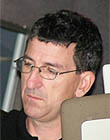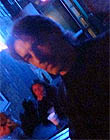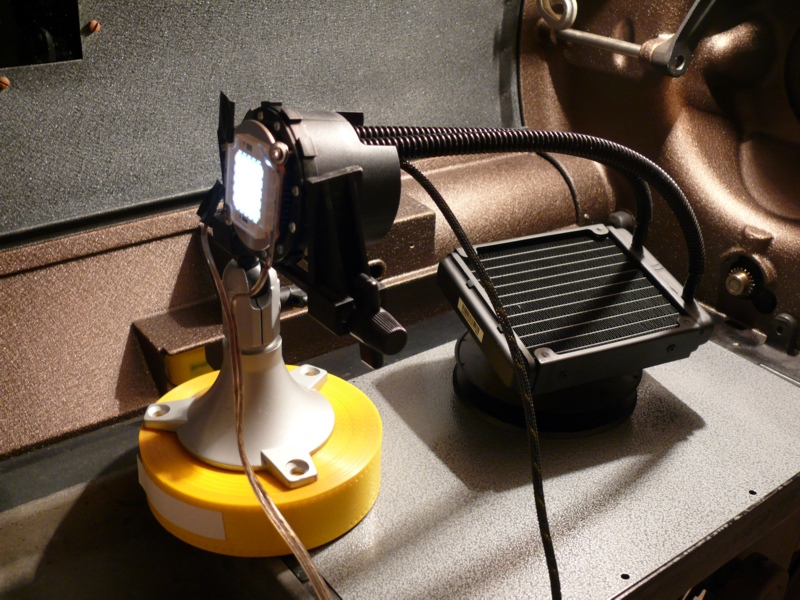|
|
This topic comprises 4 pages: 1 2 3 4
|
|
Author
|
Topic: Experiment: Replacing Xenon lamps with a LED array in an old 35mm projector
|
Marcel Birgelen
Film God
Posts: 3357
From: Maastricht, Limburg, Netherlands
Registered: Feb 2012
|
 posted 08-10-2012 01:24 PM
posted 08-10-2012 01:24 PM




I recently had a discussion with an owner of an arthouse cinema. He was complaining about the costs of replacing the Xenon Arc lamps in his old 35mm projectors.
I guess, for a small scale operation like many arthouse cinemas are, those costs can take quite a bite out of their exploitation.
During this discussion, the debate about replacing those lamps with high powered LED arrays came up. Neither of us could come to any definitive conclusion if this would lead to a satisfactory result.
LED seems to have many advantages over more traditional Xenon lamps:
- At least in theory, they should far outlive Xenon Arc lamps.
- They are far more efficient, so they consume less energy and produce less heat.
- They don't look all that expensive.
If you look at current offers, you will find all sorts of LED technology, like LED arrays that should be able to produce the same amount of light as e.g. a 5 kW Xenon Arc lamp. Also, they're available in many different color temperatures.
But, if you look at the professional projector market, nobody seems to offer any kind of LED based solution. The only LED based projectors you will find, is a limited section of home-cinema projectors.
So, what am I missing here? Why is nobody really embracing LED as a new light source? LED is the new shiny toy that gets broad application almost everywhere right now, but not in professional projection technology.
Is it because the companies that are in the game are afraid of killing the goose with the golden eggs? Just like Gillette will never ever offer any razor blades with a decent life span? Or HP that will never ever offer you an ink cartridge that prints twice as long, for the same price?
Or, am I missing something else. Is the technology not fit for professional use yet? Are there concerns about the light temperature or the brightness? Or are there any other problems I didn't think about?
| IP: Logged
|
|
|
|
|
|
Kevin Fairchild
Expert Film Handler
Posts: 125
From: Kennewick, WA, USA
Registered: Oct 2008
|
 posted 08-10-2012 03:48 PM
posted 08-10-2012 03:48 PM




I've always been curious to put one of these in a projector.
http://gizmodo.com/5880609/this-15000-lumens-led-light-cannon-will-turn-night-to-day
This 15,000 Lumens LED Light Cannon Will Turn Night to Day
You can forget about hanging it from your belt, because this miniature sun—masquerading as a flashlight—is heavy enough to need two hands to operate. And with 15,000 lumens, the XM18 is bright enough to illuminate a small planet.
As you can see, it's actually composed of 18 smaller LED flashlight components, all wrapped in a custom housing powered by 32 lithium batteries and cooled with its own fan. LEDs are definitely more efficient than incandescents, but 15,000 lumens worth still produces a lot of excess heat.
What's even crazier is that the $2,500 photon cannon (built only as a custom order) is shaped like a hexagon so multiple units can be easily mounted together. Because apparently the company is worried that 15,000 lumens might not be enough for their most discerning customers who need to blind entire herds of deer at once.
| IP: Logged
|
|
Stephen Furley
Film God

Posts: 3059
From: Coulsdon, Croydon, England
Registered: May 2002
|
 posted 08-11-2012 04:17 PM
posted 08-11-2012 04:17 PM




I've seen a video of this thing. It is indeed very bright for LEDs, but 15,000 lm is only about half the light output of a very ordinary 400 W metal halide lamp. It's not much more than the 150 W ceramic metal hides in the street lamps on the main road at the end of my road.
The luminous efficacy of xenon short arc lamps is rather low, around 40 lm/W for this 1960's 2 kW three electrode one from a tank:
web page
I doubt if modern xenons have an efficacy much greater than this, but even this one puts out 80,000 lm.
This lamp looks very similar to the ones which were used in early film projector xenon conversions.
I suppose that you could design a huge array of LED lamps and some sort of optical system to concentrate the light into a projector, but it would probably be several times the size of the projector, and cooling would be a problem; LEDs don't like getting hot.
Philips make a LED replacement for the 12 V 20 W halogen capsule lamp. It's only 1.5 W, but the light output is only half that of the halogen. It really needs to be about 2.5 W as a minimum, but at the moment they can't deal with the heat in such a small lamp.
Metal halide lamps have a considerably higher efficacy than xenons, that's the reason why the old GE Marc 300 put out more light than a xenon of the same Wattage in 16 mm portable machines, but the light quality was not as good, and the lamp life was much shorter.
| IP: Logged
|
|
|
|
|
|
|
|
|
|
Ian Parfrey
Phenomenal Film Handler

Posts: 1049
From: Imbil Australia 26 deg 27' 42.66" S 152 deg 42' 23.40" E
Registered: Feb 2009
|
 posted 08-12-2012 07:01 AM
posted 08-12-2012 07:01 AM




I've seen this idea a million times and it just won't cut it.
There are reasons why this has not taken off with the professional lamphouse manufacturers.
First off, the ideal light source is a point source. There is no way a stack of over-run led's will ever achieve this aim.
Second, in the event of a led failure (when, not if), trying to change that when compared to changing a xenon bulb will be a nightmare.
Three, in order to get anywhere near the output of a xenon bulb, the amount of led's would be huge - and this along with the associated led supplies would result in a tangled mess.
Four, for an equivalent light output, the heat thrown out from the led's and the heatsinks would rival the xenon's heat output.
Five, the number of led's would in total rival the cost of a xenon lamp.
Six, experience dictates that led's rarely live to their advertised lifespan... and if you have a dirty supply, it won't take much to fry the whole bunch.
I have looked into led's for a 16mm Debrie D16 conversion I am doing for a 20' cinema screen and the led's are a non-starter.
For the reasons listed above, I found the led conversion to be a waste of time and money - but if you want to do it for shits and giggles then give it a whirl.
But the ultimate concern I have is that if they were an effective replacement, xenons would have been replaced long ago and that just hasn't happened.(and won't in the near future)
| IP: Logged
|
|
Marcel Birgelen
Film God
Posts: 3357
From: Maastricht, Limburg, Netherlands
Registered: Feb 2012
|
 posted 08-12-2012 02:19 PM
posted 08-12-2012 02:19 PM




Thanks for all the answers so far. Well, it was obvious it wasn't just as simple as putting some big "LED bulb" into the lamp house, but after looking around a bit, I'm still not sure it is entirely unworkable.
quote:
The luminous efficacy of xenon short arc lamps is rather low, around 40 lm/W for this 1960's 2 kW three electrode one from a tank:
According to information on-line, an average LED will achieve about 80 lm/W. A modern, high-end LED could go as far as 150 lm/W. I've even found manufacturers that claim 180 lm/W, but I doubt that's accurate. So, an average LED is about twice as efficient as Xenon, at least on paper.
quote: Monte L Fullmer
...along with the Kelvin temperature being up in the 8K area .. you'd have to color time your prints to compensate..
Well, that doesn't really seem to be a problem anymore. I've done a bit of research (read: Googling around) and LEDs are available in almost all color temperatures you could wish for. So, 6500K for example, seems to be no problem.
quote: Jeff Stricker
I wonder how you could focus an array of LEDs such that all (or most) of the light energy is concentrated on the aperature?
It depends of course, on how big your array or array of arrays will be in the end, but if it gets really big, you will need a very big lens, which is quite expensive of course. Maybe it's a stupid idea, but why not put a Fresnel lens in front of it? ![[Smile]](smile.gif)
Sure, you would need a Fresnel lens that could cope with the heat.
quote: Ian Parfrey
First off, the ideal light source is a point source. There is no way a stack of over-run led's will ever achieve this aim.
Maybe I'm mistaken here, but wouldn't be the ideal light source a rectangle with equal light intensity across the surface with exactly the same aspect ratio as the aperture?
quote: Ian Parfrey
Three, in order to get anywhere near the output of a xenon bulb, the amount of led's would be huge - and this along with the associated led supplies would result in a tangled mess.
I've found some suppliers that offer single-chip LED arrays that claim to achieve 500W or even up to 900W. Those modules are just a few square inch in size. Of course, I don't know if those are any good, but to achieve the same output as a small Xenon bulb you, in theory, would only need a single one of them or maybe just two or three.
quote: Ian Parfrey
Four, for an equivalent light output, the heat thrown out from the led's and the heatsinks would rival the xenon's heat output.
Sure, where there is a lot of energy, there is almost certainly a lot of heat. But still, the amount of heat emitted by those LEDs should be still quite a lot less than that of Xenon bulbs. Still, it isn't a problem to cool the Xenon lamps, so it should be no problem to cool LEDs, given the heat-sinks offer sufficient surface.
quote: Ian Parfrey
Six, experience dictates that led's rarely live to their advertised lifespan... and if you have a dirty supply, it won't take much to fry the whole bunch.
The most LED arrays I've found advertise with a lifespan of about 50.000 hours. Well, if they even could achieve 1/5th of that, it would far outperform Xenon.
quote: Ian Parfrey
But the ultimate concern I have is that if they were an effective replacement, xenons would have been replaced long ago and that just hasn't happened.(and won't in the near future)
Yeah, I share that concern. But I'm still not entirely sure that's because the technology doesn't work, or simply because selling the actual lamps is like selling those refill ink cartridges: quite a profitable business.
| IP: Logged
|
|
|
|
|
|
|
|
|
|
|
|
All times are Central (GMT -6:00)
|
This topic comprises 4 pages: 1 2 3 4
|
Powered by Infopop Corporation
UBB.classicTM
6.3.1.2
The Film-Tech Forums are designed for various members related to the cinema industry to express their opinions, viewpoints and testimonials on various products, services and events based upon speculation, personal knowledge and factual information through use, therefore all views represented here allow no liability upon the publishers of this web site and the owners of said views assume no liability for any ill will resulting from these postings. The posts made here are for educational as well as entertainment purposes and as such anyone viewing this portion of the website must accept these views as statements of the author of that opinion
and agrees to release the authors from any and all liability.
|

 Home
Home
 Products
Products
 Store
Store
 Forum
Forum
 Warehouse
Warehouse
 Contact Us
Contact Us




 Printer-friendly view of this topic
Printer-friendly view of this topic













![[Smile]](smile.gif)





